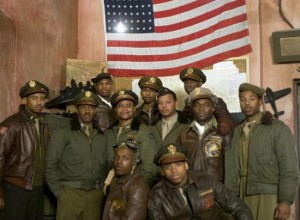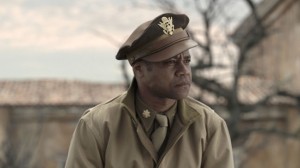Interview: Cuba Gooding, Jr. and Anthony Hemingway of ‘Red Tails’
Posted on January 19, 2012 at 8:00 am
 Actor Cuba Gooding, Jr. and director Anthony Hemingway sat down with a small group of critics to talk about their new film, “Red Tails,” the story of the Tuskegee Airmen, the highly decorated heroes who flew missions in the still-segregated Army of WWII. It was the dream project for producer George Lucas.
Actor Cuba Gooding, Jr. and director Anthony Hemingway sat down with a small group of critics to talk about their new film, “Red Tails,” the story of the Tuskegee Airmen, the highly decorated heroes who flew missions in the still-segregated Army of WWII. It was the dream project for producer George Lucas.
This was Gooding’s second time playing a member of this legendary group. He appeared in the 1995 made-for-cable The Tuskegee Airmen. “It’s like you’ve been researching the role for 12-15 years,” he said. “The first one was more about their training and the racism and hardships and culminated with their first intro to the war effort and the first dogfight. This was George Lucas’ passion project to display the warriorism and the heroism that are the Tuskegee Airmen in combat. So this movie opens up during the war and we meet these guys after the’ve been in training for as many months as they will actually engage in combat. This is the roller coaster ride. Some of the footage in this movie, you feel like you’re in one of those P51 cockpits when they’re flying. You feel like you’re being shot at by the German Messerschmitts. It’s everything I wanted the first one to be!”
Director Anthony Hemingway talked about putting the actors through flight training. “It was fun! To actually experience that G-force. You hear about it but you can’t really connect with it unless you go through it. We did actually fly in a real P51.” Gooding said he was inspired by classic WWII movies and by real-life heroes like General Benjamin O. Davis, the commander of the Tuskegee Airmen. That still strength that he portrayed, the way he carried himself, was what I wanted to resonate with my character and echo and mirror.”
Hemingway said the movie is very relevant today because it relates to all struggles that people face. “Seeing the obstacles that they overcame so brilliantly, the perseverance there, we can learn from that.” “Selfless sacrifice is what these guys represented and dedication to our country over themselves is something our men and women overseas today can absolutely identify with,” added Gooding. “I like to say this is my love letter to the armed forces, no matter what branch you’re in, no matter what race you are.” “It’s our salute for their service,” said Hemingway.
They had just come from the White House. “It was beautiful to see all these legacies coming together in one room,” Hemingway said. “A handful of the real airmen who flew in combat, our first black President, George Lucas. Honestly, it was a beautiful experience. We sat in the family theater in the White House and screened my first film. And we were in Houston and George and Barbara Bush were there and she walked out bawling because she was so moved by the film. They’ve asked to be able to show it to George W. and his family.” They were just as thrilled at a big premiere at the Zeigfeld theater when an elderly woman came over to introduce herself as a Tuskegee Airman. She was Nancy Colon, a nurse. “It was an all-black airbase in the segregated military so every face there was black.”
Gooding said that when he heard about the project he insisted on meeting with producer George Lucas to demonstrate his passion for the project and joked that he would be willing do do anything, even the catering for the set. Lucas warned him it would be a tough shoot, down and dirty. “I’m in!” was Gooding’s response.
I asked Hemingway about how he as a director worked to allow the acting of the combat scenes come through when the characters had their faces obscured by oxygen masks. “We took a little creative license. There are four or five action sequences in the film and in the first two I took the liberty of not using the masks to enable you to connect with the characters. Once we got there, if you didn’t know who the characters were, we failed. By then you could identify them by voice and in the casting of it, knowing from the beginning that their faces would be covered, we worked to make sure that the palette of the cast, the hues of their faces would help you easily stay connected to the story.”
Hemingway told us with tears in his eyes of the privilege he felt to present the legacy of the Tuskegee Airmen. He did a great deal of research at George Lucas’ Skywalker Ranch, were huge amounts of information and resources had been assembled for him, but he also went to Tuskegee to “walk in their footsteps” and see where the men had trained and where First Lady Eleanor Roosevelt made her famous visit to fly with one of the Tuskegee-trained pilots.
 They spoke about what it meant to them to have four of the real Tuskegee Airmen on the set with them every day, sharing their stories and providing support and guidance. Gooding said it meant a lot to him to see the real heroes inspiring the young actors who were playing them. “The first real wow for me was when I would sleep in the car on the way to the set because we would start shooting at 5 am to get the light. I would wake up and we would be on this airbase, back in time.” Hemingway said that one of the Airmen, the late Lee Archer, lifted up his cane to point at the aircraft and said, “Get rid of all you civilians and I’ll be back in the air.” He got choked up telling Hemingway that when he was growing up everyone said they couldn’t do it. “To see the story being told meant so much to him.”
They spoke about what it meant to them to have four of the real Tuskegee Airmen on the set with them every day, sharing their stories and providing support and guidance. Gooding said it meant a lot to him to see the real heroes inspiring the young actors who were playing them. “The first real wow for me was when I would sleep in the car on the way to the set because we would start shooting at 5 am to get the light. I would wake up and we would be on this airbase, back in time.” Hemingway said that one of the Airmen, the late Lee Archer, lifted up his cane to point at the aircraft and said, “Get rid of all you civilians and I’ll be back in the air.” He got choked up telling Hemingway that when he was growing up everyone said they couldn’t do it. “To see the story being told meant so much to him.”
They spoke about the commitment George Lucas had to the story, putting up his own money for the feature film and for a documentary narrated by Gooding called “Double Victory.” “One of the first things Lucas told me was, ‘You focus on the story, the shooting, the acting, the I got your back on the flying.'” He’s been studying the dogfights for years and I was confident knowing the support was there.
Gooding said, “Come see the movie because it’s action/adventure and a statement and an American tale. President Obama stood in front of the screen, and we were all so emotional, and he said, ‘This is an American tale of heroism.’ That’s why people should come to this movie.”
